https://www.musical-u.com/learn/music-mentor/
There’s no denying that it takes a lot of personal motivation and dedication to succeed in meeting one’s musical goals. Having a mentor to help you on your journey can take you a long way! Learn more about finding a mentor for your music today! https://www.musical-u.com/learn/music-mentor/
Sight Reading, Vocal Wisdom, Computer Creations, and Music at a Glance
When we’re engrossed in musical learning, we often forget to evaluate our progress and seek ways to improve or accelerate our trajectory.
This week, we’re encouraging you to reflect on your musical journey, and think about how you can take both your learning and your practice to the next level.
We examine how sight reading can become musical rather than mechanical, how one vocal instructor pushes the boundaries of teaching singing, and how you can use technology to push the limits of your songwriting process.
Sight Reading
Undoubtedly one of the most impressive musical skills out there is sight reading, or a musician’s ability to simply look at a piece of sheet music, take a deep breath, and play it as effortlessly and musically as if they had practiced it a hundred times before.
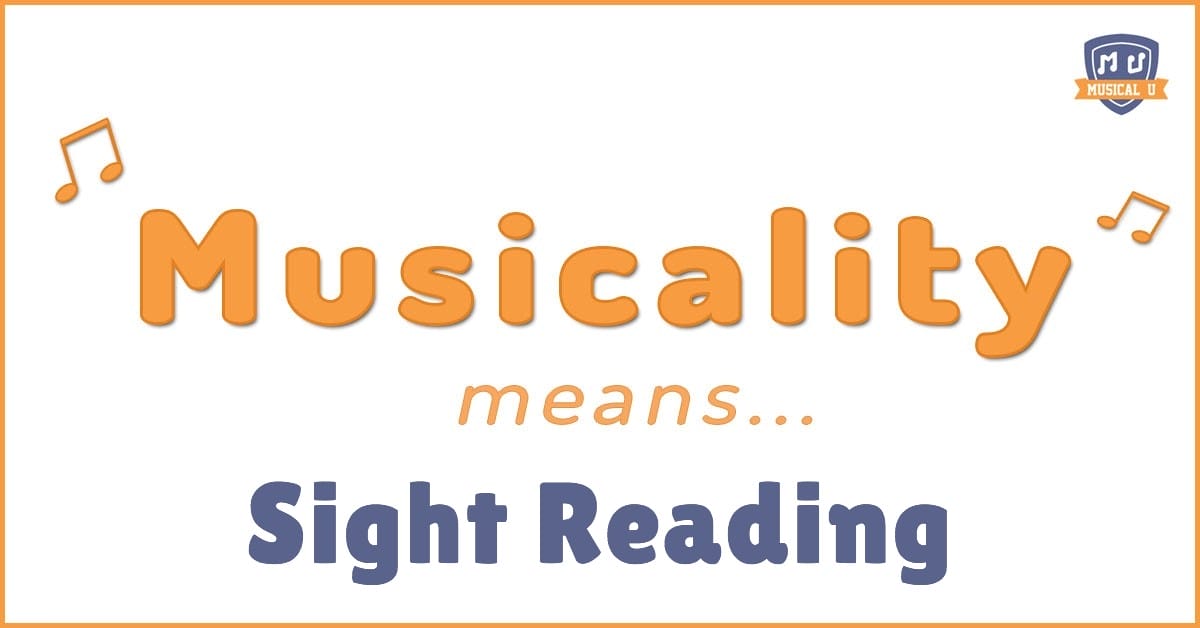 In Musicality Means… Sight Reading, we examine this skill, the obvious and not-so-obvious musical benefits that come from mastering it, and how you can begin practicing it in a way that won’t leave you feeling discouraged.
In Musicality Means… Sight Reading, we examine this skill, the obvious and not-so-obvious musical benefits that come from mastering it, and how you can begin practicing it in a way that won’t leave you feeling discouraged.
Most importantly, we share a hidden “trick” to effective sight reading – an approach that goes beyond the note-by-note tactic, and gives you a deeper understanding of the music you’re playing.
Learning how to sight read doesn’t happen overnight. It takes years of deliberate practice to get comfortable and proficient with this skill. No matter your current abilities, there is always room for improvement – Peppermints and Cherries shows you how.
It’s such an interesting age to live in, with the explosion of mobile technologies! It seems like there is an app for nearly everything, and this includes sight reading. The Curious Piano Teachers take you through a review of a new sight reading app from ABRSM.
Becoming a great sight reader is a neverending journey, which is exciting because you know that there is always something new to do! The Hoffman Academy discusses how to improve your reading skills by building a solid foundation.
Vocal Wisdom
For those who use their voice as their primary instrument, there are considerations that no other musician needs to even worry about. For starters, getting in tune and staying in tune isn’t as easy as just finding the note on your instrument.
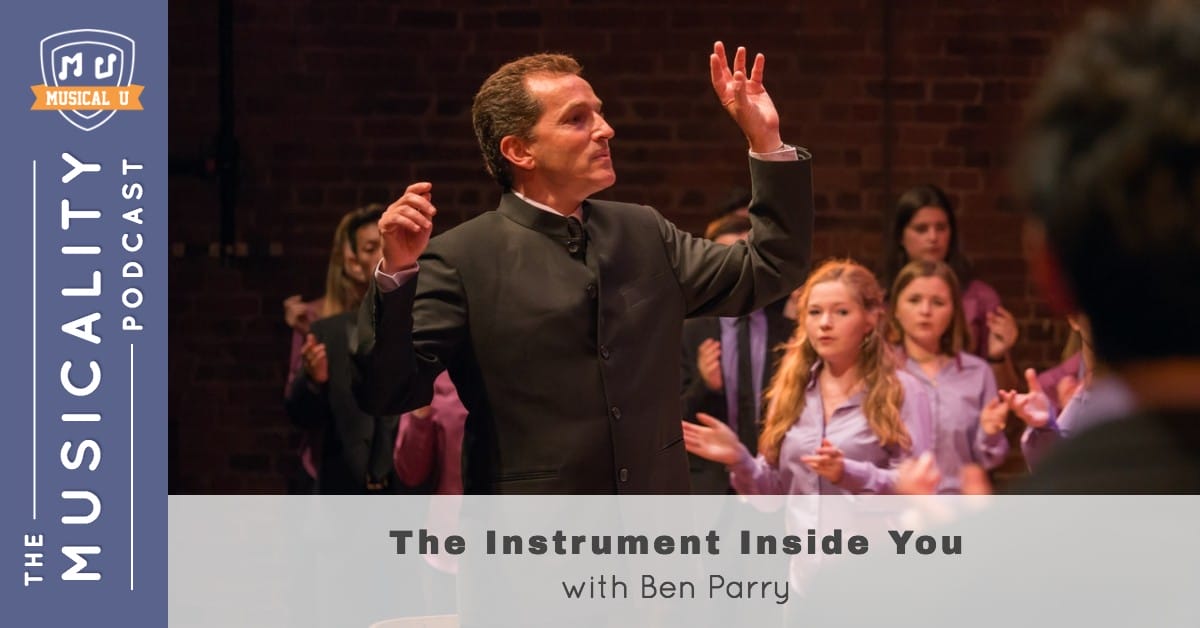 And naturally, things get more complicated when you put singers together in a group and ask them to sing in tandem; how does a choir or an a cappella group stay in tune?
And naturally, things get more complicated when you put singers together in a group and ask them to sing in tandem; how does a choir or an a cappella group stay in tune?
In The Instrument Inside You, with Ben Parry, the veteran choir director, singer, and arranger shares a goldmine of wisdom on the unique challenges of a cappella singing, the pros and cons of the two approaches for learning relative pitch, and how the lessons learned through his rich music career have influenced his supportive and accessible (yet totally boundary-pushing) teaching style.
Ben has such an personal inspiring story that it may encourage you to explore your own singing. For some musicians, discovering their musical voice is full of self-doubt about their abilities and comparing themselves to other singers. But as Steven M. Demorest discusses, ultimately, everyone can sing!
Like many of the musicians that we talk to on the podcast, Ben initially discovered his love for music as a child. Children are naturally curious about a great many things, and discovering their singing voice can be exciting and rewarding for their overall growth. Ashley Danyew discusses more about how to help children start singing.
Here at Musical U, we share a passion with Ben for a cappella music, and we are always encouraging other musicians to explore this unique musical expression. Become Singers discusses singing a cappella, with some tips on how to sing professionally.
Computer Creations
The advent of digital audio workstations (or DAWs, for short) has made electronic music production accessible, intuitive, and fun. No longer do you need a collection of synthesizers, drum machines, samplers, and effects pedals to make tunes – it’s all there for you, waiting in Ableton, Garageband, Logic Pro X, or whichever software suits you best.
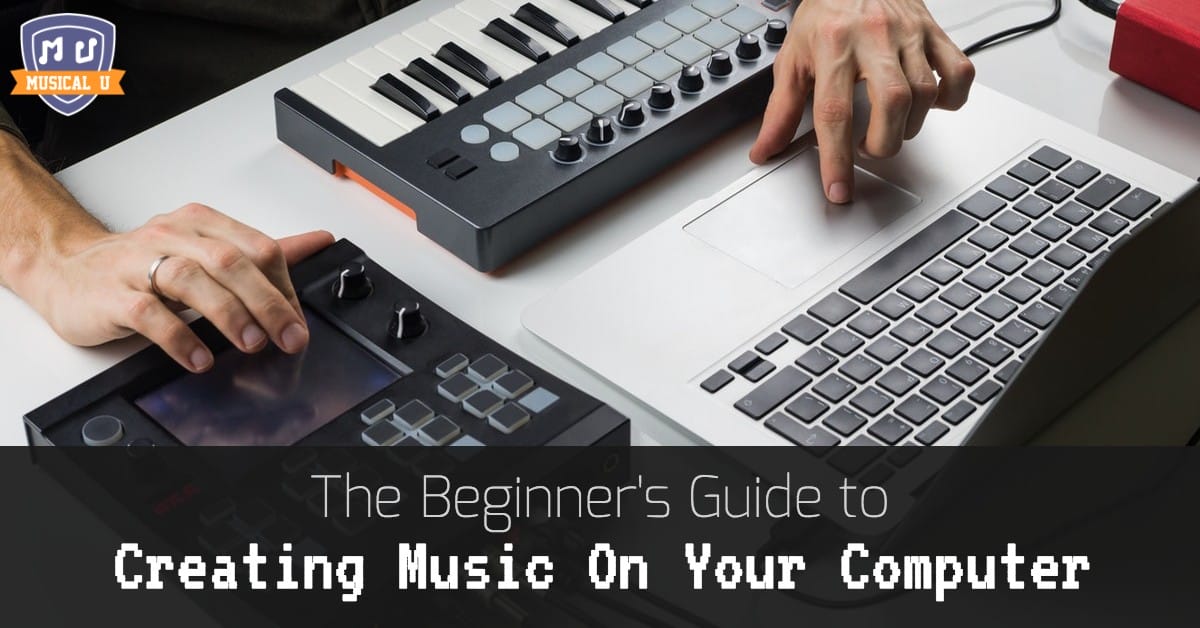 Learn about the basics of computer-based musicmaking with The Beginner’s Guide To Creating Music On Your Computer, which covers everything from the gear you’ll need to get started, to the types of audio files that you can work with and the ways in which DAWs make arranging, mixing, and adding effects a breeze.
Learn about the basics of computer-based musicmaking with The Beginner’s Guide To Creating Music On Your Computer, which covers everything from the gear you’ll need to get started, to the types of audio files that you can work with and the ways in which DAWs make arranging, mixing, and adding effects a breeze.
If you’re more interested in using a DAW to compose and arrange with an instrument you already play, then don’t skip this guide – we also explore how this software can help you create music with a non-virtual instrument, with the use of recording, arranging, looping, and effects!
It’s truly a fascinating time to be a musician, as technology has allowed us to do things that weren’t possible only a couple of years ago. In no way is that more apparent than in the evolution in home recording technology. For an in-depth discussion on how to create a professional recording studio at home, we turn to Bree Noble at Female Entrepreneur Musician.
If you have already set up a recording studio, no matter how basic or complex, it’s time to lay down some tracks! The process to record music is different than how you would rehearse. It’s best to think of a strategy for getting the most out of your recording sessions, as Music Tech Student discusses.
The same technology that allows us to easily record music has also permitted us to share and collaborate with other musicians via the internet. One example of this is the number of teachers that teach exclusively online. For some suggestions on how to get yourself set up to stream your music performance, we turn to Emily Dolan Davies and Airgigs.
Music At A Glance
Learning to sight read in the traditional way involves a lot of trial-and-error and a lot, lot, lot of repetition. The result? You can play a piece note-by-note as you are reading the sheet music, with your brain translating each note on the page into movement of your fingers.
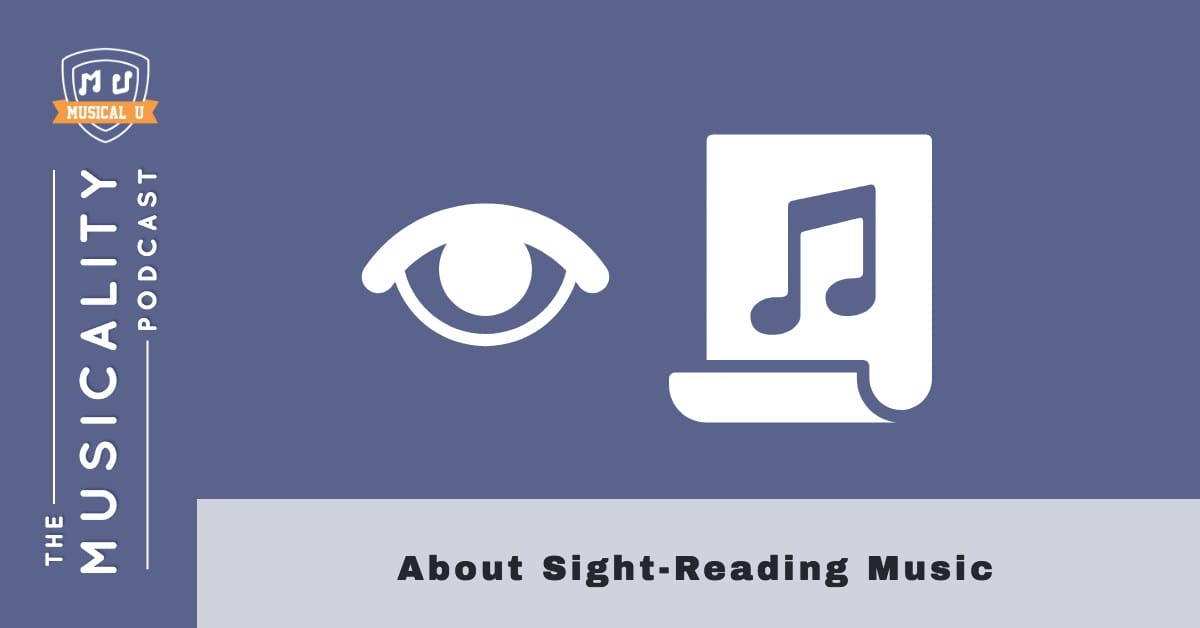 Though this is certainly impressive, it’s hard to play in a musical and expressive manner if you are stuck in this note-by-note mindset!
Though this is certainly impressive, it’s hard to play in a musical and expressive manner if you are stuck in this note-by-note mindset!
In About Sight-Reading Music, we go beyond the bare-bones skill of playing from the page, and share the secret of infusing your sight reading with musicality – something that will improve your playing and deepen your understanding of the music.
In your musical toolbox, the ability to sight-read is some kind of Frankenstein combination all-in-one craftsman super tool. You can apply this skill to nearly every aspect of your musicality! Read Melanie Spanswick’s 15 top tips to successful sight reading to get you started.
Learning to be a music teacher has helped many musicians improve their confidence as a musician. However, sight reading is a particularly difficult skill to teach. Diane Hidy has ten tips for effectively teaching sight reading.
No matter how long you have been sight reading, or how proficient you are at this task, there is always more work to be done. Indeed, sight reading is a foundational skill and is best if practiced a bit every day. Start Piano Studio explores making sight reading an everyday exercise on their blog.
Remaining A Step Ahead
Get into the habit of looking at your musical journey and asking yourself the question, “How can I learn this skill or concept in a way that will most benefit my musicality?”.
Keep the idea of deliberate practice in your head. While adding a skill to your musical toolbox is an accomplishment in itself (and one you should be proud of!), think about how you can learn the skill as effectively as possible, so you can apply to it to a broad range of musical situations.
This sort of pragmatic thinking is what will take you from a technically skilled player to an expressive musician.
How do you evaluate your own progress? Writing in a journal about the skills you are learning, how you are learning them, and the progress you are making is a fantastic way to critically examine your learning journey.
The post Sight Reading, Vocal Wisdom, Computer Creations, and Music at a Glance appeared first on Musical U.
What is it about a breakup that inspires songwriting? We …
https://www.musical-u.com/learn/since-youve-been-gone-11-post-breakup-songs-to-help-you-make-it-through/
What is it about a breakup that inspires songwriting? We compiled some of our favorite breakup songs throughout the years. What’s yours?
https://www.musical-u.com/learn/since-youve-been-gone-11-post-breakup-songs-to-help-you-make-it-through/
A phenomenal way to get out of a rut and making your prac…
https://www.musical-u.com/learn/learning-by-repetition-how-musicians-can-improve-with-looping/
A phenomenal way to get out of a rut and making your practice more interesting is to use looping. What is looping? Today we explore how to start with the experts at Looping Live Magazine https://www.musical-u.com/learn/learning-by-repetition-how-musicians-can-improve-with-looping/
About Sight-Reading Music
Are you intimidated by the idea of sight reading music, finding the skill to be intimidating and unattainable? This podcast episode explores how you can get started with learning this skill through musicality training, and the endless benefits that this ability yields.
Listen to the episode:
Links and Resources
- Interview with Ben Parry
- SightReadingMastery.com
- Solfa and Relative Pitch
- Speak Rhythms module preview
Enjoying The Musicality Podcast? Please support the show by rating and reviewing it!
Transcript
Today I wanted to talk about sight reading – a musical skill that a lot of musicians find intimidating, difficult, or even impossible.
On our last episode with Ben Parry we talked about a particular kind of sight-reading: when a choir singer looks at traditional sheet music they haven’t seen before and can directly sing the notes on the page. But sight-reading is something that’s useful beyond classical music, applies on any instrument, and although I’m going to be talking in terms of traditional “score notation”, everything we’ll discuss is relevant for chord charts, lead sheets, guitar tab, or any other form of written music.
Sight reading is a valuable skill for any musician to add to their toolkit, and learning to do it doesn’t have to be dry or difficult. Today I’d like to share with you three ways that musicality can enhance and accelerate the process of learning to sight-read for you.
First of all, let’s make sure we’re clear: Sight-reading is different from simply reading music.
Reading music means you can interpret the written symbols on a page and know the musical notes they represent. You might sit down with a piece of sheet music and spend 30 minutes deciphering it note by note – and you are reading the music. But that’s not sight-reading.
Sight reading music means you play it as you read it. You’re essentially performing the music directly from the page, the first time you see it. That obviously requires a much greater familiarity and speed of reading music than the slow-methodical “figuring it out” which also counts as reading music.
Learning to read music is very quick. You need to understand the concepts and the symbols but you don’t need to practice it very much to say that you can read music and to take that skill to any new written music you encounter.
Learning to sight read music on the other hand takes a lot of time and practice to master. This is why it’s typically included as a short test as part of an instrument exam, you get given some notated music you haven’t seen before, normally at a level a couple of notches below what you’ve been carefully learning to play for the exam, and after a short amount of prep time to examine the sheet music you’re asked to play it.
Learning to sight read music is traditionally just a process of repetition. You practice it as a skill in itself, and your brain gradually gets faster and faster at translating the visual symbols on the page into the correct movements of your fingers on the instrument.
This is a pretty well-established process and it works fine. There’s a website I recommend for learning this way, SightReadingMastery.com. They have a really nicely designed database of exercises to take you from the very basics through to quite advanced sight reading, on a variety of instruments. So check out SightReadingMastery.com for lots of material to practice with.
Today though, I wanted to help you see beyond this traditional approach by asking the question: what does this have to do with musicality?
This isn’t the “Music Podcast”, it’s not the “Sight Reading Podcast” and it’s certainly not the “Pass your music exams Podcast”! So why are we talking about sight reading on the musicality podcast?
Well, apart from the fact that being able to sight read is a valuable skill for any well-rounded musician because it unlocks such a vast treasure trove of music to you in books and downloadable sheet music, for you to instantly play and add to your repertoire. Apart from that very good reason to learn to sight read, it’s relevant for musicality because the way to accelerate learning to sight read is to work on actually understanding the music within the symbols.
Traditional sight reading is very mechanical. You mentally translate dots and squiggles on the page into the corresponding finger motions and you reproduce the music with your instrument.
But wouldn’t it be better if those dots and squiggles meant something? If you actually had a deep understanding of why it’s those particular dots and squiggles that are on the page?
As you’ll know if you’ve been listening to this podcast for a while, we’ve set up Musical U as the home of musicality training online, and so to help explain the musicality of sight reading I’m going to share with you three ways that Musical U’s training can help you become a better sight reader – even though we don’t specifically have any sight reading material inside Musical U at all.
The first way Musical U helps you sight read is the one that’s most relevant to what we were talking about with Ben Parry: and that’s the pitch skills needed to interpret written note pitches. If you’re a singer then learning to sight read is actually a much bigger challenge, because you don’t just need to know which fingers to put where to produce the notes on the page – you actually need to know in your head how those notes should sound. It’s 100% up to you to produce the right pitch for each note – that’s quite different from say piano, where you see a written “C” so you press the “C” key on your piano keyboard and you know the right note pitch will come out!
So the first way musicality training can help you sight read is by training your sense of relative pitch. We have two methods for this at Musical U, intervals and solfa, and whichever you pick they both enable you to look at the dots on the page and imagine in your mind how those notes would sound. So that’s obviously hugely useful for a singer trying to sight read – but it’s actually really valuable for any instrumentalist, because imagine how much more musical you can make your performance if you could actually hear the music in your head before you play it, rather than having to wait until your fingers hit the keys to know how it will sound.
By developing your sense of relative pitch and practicing the skill of audiation, meaning imagining music in your mind, you become able to just look at a page of sheet music and hear the right note pitches in your head.
Of course there’s another dimension to every note on the page, and that’s rhythm. This is the second way musicality training can help you with sight reading. At Musical U we have a “Speak Rhythms” module which is essentially the rhythm equivalent of what we just talked about for pitch. We teach two methods you can use to look at written rhythm notation and hear in your head (or speak out loud) how those rhythms would sound. So combine this musicality skill with the relative pitch training and you can look at a piece of written music and hear exactly how those notes should sound, both in their pitch and in their rhythm.
Pretty cool, right? I know that for a long time I thought it was astounding to imagine that some expert musicians could flick through sheet music in a shop and would actually be hearing that music in their head as they looked at the page. And that other singers in choir with me could be handed new sheet music and immediately sing their part, even though they’d never heard that piece before.
With your pitch and rhythm ear skills connected to notation the way we teach it at Musical U those seemingly-magical abilities are well within your reach.
The final way that musicality training helps you with sight reading is the most closely related to what I said about understanding the music you’re sight reading. The pitch and rhythm skills are great for translating what you see into something you can hear in your head. But you don’t necessarily know what’s going on in the music at all, just how it would sound.
One popular technique for speeding up your sight-reading is the idea of “chunking”, where instead of reading one note at a time, you break up what your eyes are taking in into “chunks” of several notes at once. And this is where musicality training can really help. Imagine a bar of piano music, for example, played both hands together with the left hand playing chords and the right hand playing a melody. Without musicality training you might have to decipher a dozen different notes for the left hand and another half dozen for the right hand. But if you’ve studied melodies and harmony the way we teach them at Musical U then you could glance at that same bar of sheet music and immediately see that actually it’s just two chords in the left hand, C major followed by F major, and it’s mostly just a little section of the ascending melodic minor scale in the right hand. You’ve converted a large number of dots into a few simple concepts – and not only do you know how those sound in your head, but you’ve played them so many times that it’s easy to just run your hands through playing them, without having to think about each note in turn.
An equivalent on guitar would be if for example you’d done some training on scale degree recognition and learned particular fretboard patterns for common scale types. You could glance at some guitar tab and instead of just seeing an overwhelming assortment of different fret numbers your eyes would perceive the underlying shapes and patterns and you could immediately make your fingers do the right things – again, without having to think through it carefully, one note at a time.
Or supposing you’re a rhythm guitarist presented with a new chord chart. Without musicality training you might look at the page and see 20 or 30 different chord symbols you’d have to play through and pay total attention to every change. But after training in chord progressions and song structure you could look at that same page, immediately see that there’s an A section and a B section, and each one is a simple 1-4-5-6 progression in a particular key. Again, you’ve distilled down a large amount of information into something you could say out loud in a sentence or two, making it dramatically easier to play through – and, by the way, dramatically easier to memorise, another skill that can otherwise be very slow and challenging for musicians to learn.
So musicality gives you the insight into the underlying structures and patterns that music is made from, and that lets you translate what initially seems like a ton of information notated on the page into the simple, larger chunks it’s composed from. That lets you more easily play it on your instrument because your brain has much less to juggle and you’re able to take advantage of all the practice you’ve had playing those same chunks in different music before.
So those are three ways that musicality training can really speed up the process of learning to sight read music – as well as making it a lot more rewarding and enjoyable, and letting you make your sight-read performances sound much more musical too.
On this show we talk a lot about the ear skills of music and things like playing by ear and improvising which don’t require you to read music. But that doesn’t mean that the other, more traditionally-taught skills aren’t incredibly useful too. So if you’ve shied away from sight reading because it seemed difficult, or you’ve been learning but finding it slow-going, please do check out SightReadingMastery.com for some step-by-step practice material, and explore the three ways that musicality training can help speed up the process and make it a whole lot more fun too.
The post About Sight-Reading Music appeared first on Musical U.
Eager to add a new instrument to your repertoire? The Uku…
https://www.musical-u.com/learn/how-to-play-ukulele-by-ear/
Eager to add a new instrument to your repertoire? The Ukulele is one fun little instrument that you are sure to enjoy! Learn some tricks to play the Uke by ear with Ukulele Go https://www.musical-u.com/learn/how-to-play-ukulele-by-ear/
We often hear about the importance of finding the tonic o…
https://www.musical-u.com/learn/finding-tonic-major-keys/
We often hear about the importance of finding the tonic of a song. Learn how to unlock this musical mastery with the Musical U team! https://www.musical-u.com/learn/finding-tonic-major-keys/
Too many people go through life worried that they can’t s…
https://www.musical-u.com/learn/11-tips-to-help-the-tone-deaf-sing-in-tune/
Too many people go through life worried that they can’t sing. The reality is that they just haven’t learned how to yet. Even the most seemingly-tone-deaf singers can learn to sing in tune. Here are 11 tips which can help anybody learn to sing in tune. https://www.musical-u.com/learn/11-tips-to-help-the-tone-deaf-sing-in-tune/
The Beginner’s Guide To Creating Music On Your Computer
Learning to create music on my computer has been one of the most creatively fulfilling experiences of my life. I’m here today to convince you that it’s not as difficult as you may think. In fact, many of you will be able to get started making music today.
If you have a computer, you only need a few other pieces to get started. This article will cover exactly what you need (as well as what you don’t need). I’ll provide a quick introduction to the different recording options, as well as tips for arranging and mixing your tracks on the computer.
The goal of this article is to inspire everyone from those new to making music to seasoned pros. You don’t have to buy an expensive home studio, nor do you have to be technically gifted – all you need is a love for making music.
With that, let’s jump right in!
Gear Overview
Before we dive into the meat of the article, a quick gear checklist is in order. You may be surprised to find that you have most of the gear you need. However, there are a few pieces of equipment that you need to consider, and a few you can ignore while you’re just getting started. This includes:
- DAW (digital audio workstation)
- MIDI controller
- Audio Interface
- Mixing Equipment
Your DAW
As you would expect, the most crucial piece of the puzzle comes in the form of software. Namely, DAWs, or digital audio workstations. DAWs are programs that run on your computer that allow you to record, edit, and produce audio files. As you may expect, there are a number of different options on the market. The good news is, you can always get your hands on something for free. Here are my recommended free options:
- GarageBand (Apple iOS only)
- Pro Tools First
- Ableton Live Lite (comes with purchase of certain MIDI controllers)
There will be limited capabilities with each of these free DAWs, but they’re a great way to get a feel for what creating music on your computer is like.
Alternatively, for those who want the full versions, some of the most popular DAWs for creating music are as follows:
- Logic Pro X
- Fl Studios
- Ableton Live
- Reason
- Cubase
Most of these options will have a free trial period where you can test them out. Another great way for you to get your hands on a DAW without spending any of your hard earned cash!
This list isn’t comprehensive – there are plenty more options available. Make sure you do your research before pulling the trigger. Keep in mind that some DAWs are better than others for certain genres. For example, Ableton is often the choice of DAW for creating electronic music.
MIDI Controller
The next piece of equipment you need to consider are MIDI controllers. MIDI (short for musical instrument digital interface) is a protocol designed for controlling digital instruments. It does not produce any sound, rather, it simply transmits information on how the music was produced.
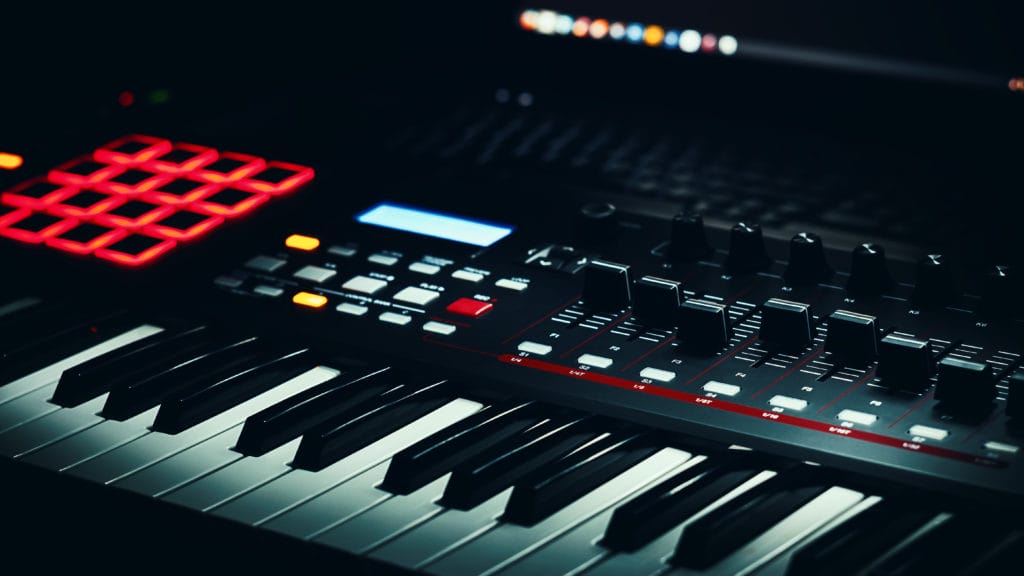
In other words, MIDI is what allows your electronic instruments and your DAW to communicate with each other.
The easiest way to create MIDI information is with a MIDI controller. MIDI controllers usually come in the form of basic keyboards. The main difference is the MIDI controller only produces MIDI information and no sound.
Your MIDI controller doesn’t have to be complicated. I recommend getting something with just the basic MIDI features – something like the AKM320 midiplus. All of the other bells and whistles that come with fancier MIDI controllers can easily be controlled in your DAW.
If you’re really on a shoestring budget, you can skip the MIDI controller altogether. It will make things a little harder, but there are plenty of producers I know who only use their keyboard and mouse.
Audio Interface
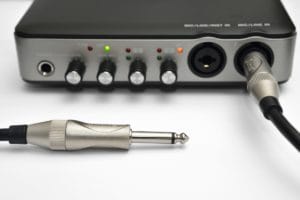 Anyone who wants to record their instrument needs an audio interface. Audio interfaces provide the link from your computer to any of your external hardware. This includes your piano, guitar, headphones, monitors, and microphone.
Anyone who wants to record their instrument needs an audio interface. Audio interfaces provide the link from your computer to any of your external hardware. This includes your piano, guitar, headphones, monitors, and microphone.
The quality of audio interfaces today is at a point where you can get professional results from entry-level interfaces.
Again, there are plenty of options for you to choose from. Getting something with just the basic features is a great place to start. Make sure the interface is able to accommodate any instrument you’d like to record. Recording Revolution goes through a quick rundown of some of the more popular options:
Mixing Equipment
Many artists who begin making music on their computers fail to realize one very important thing: mixing is almost half the battle. They underestimate the power that mixing has on the overall sound of the track.
This is why mixing equipment is widely discussed amongst the DIY community.
What kind of equipment are we talking about here?
Most of us will be able to get away with two pieces of mixing equipment:
- Mixing headphones
- Studio monitors
We can ignore the expensive multitrack mixers, analog reverbs, compressors, etc. Most of this hardware has now moved to digital and will be included with your DAW.
 However, headphones and monitors are essential for getting quality mixdowns. The good news is, you won’t need to purchase mixing specific equipment to get things moving. I waited a few years until I had the production side of the coin under wraps before I bought my first set of mixing headphones.
However, headphones and monitors are essential for getting quality mixdowns. The good news is, you won’t need to purchase mixing specific equipment to get things moving. I waited a few years until I had the production side of the coin under wraps before I bought my first set of mixing headphones.
Why can’t you just use your regular headphones or speakers?
Well, the short answer is: accuracy. Consumer headphones and speakers have their frequency spectrums adjusted in order to color the recording. The end result is the tracks usually sound “nicer” on consumer products.
Unfortunately, mixing with colored frequency spectrums makes it incredibly difficult to accurately hear what you are mixing. You want what is called a “flat frequency” spectrum. Mixing headphones and monitors provide this flat frequency spectrum for the best accuracy possible. The idea is, if you can get the mix sounding good on studio monitors, it will sound fantastic on consumer systems. I’ve created a beginner friendly guide on selecting studio monitors.
That wraps it up for the gear required. I suggest starting off with one of the free options for DAWs and working your way into getting the other gear required.
Types of Audio Files
Now that we’ve got our gear situation sorted, let’s understand how music on your computer is stored as files.
There are two different types of audio files you will be using to create music: MIDI and audio. They both have pros and cons, and producers usually have a preference for which file type they like to work with.
That being said, most projects are a mix of audio and MIDI files, so it’s important to become familiar with them both.
Audio
When you think of a recording of audio you are probably picturing the audio file format. It can look something like this:

You see a visual representation of the audio wave, as well as information of the stereo field and gain of the recording.
This is the kind of file you will record whenever you are using physical instruments. Many of the sample recordings (professional recordings of instruments) and loops will be recorded as audio.
Producers generally like to work with audio because it’s much easier on their computer’s processor. It’s also much easier to mix and clean up audio files. You can easily remove sections, blend things together, change the length, pitch and tempo. The only downside to audio files is you cannot change the musical aspect of the recording.
MIDI
This is where MIDI files start to become beneficial. Here’s what MIDI files look like:

Because the information is recorded in MIDI, you can use the same file to control any style of digital instrument. You can change the overall musical structure of the recording, such as the note arrangement, the chords, and the velocity.
The downside is MIDI takes a lot of processing power if you are running multiple MIDI tracks concurrently. It’s also more difficult to make adjustments to the midi recording. The good news is, once you are happy with the musical arrangement of the file, you can easily bounce the MIDI down to audio and finish your editing.
Having a basic understanding of the two main file types will go a long way when you are beginning to make music. In summary, MIDI is to be used to control any digital instruments and audio files will be used to record any physical instruments.
Arranging and Layering
A huge advantage to modern DAWs comes in the form of workflow. The modern interfaces make recording and arranging your songs incredibly intuitive. Have a quick look below at a new track I just started working on:
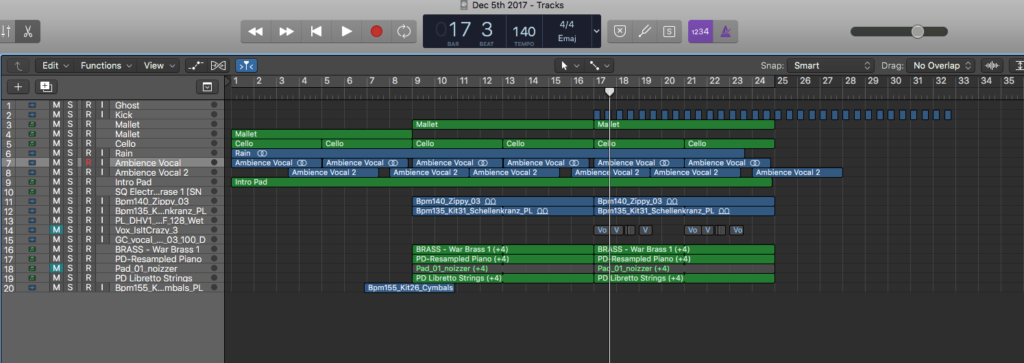
The different tracks can easily be arranged and layered. You can copy and paste different sections and easily loop different components.
Each track can be edited individually, or as a group of tracks.
Producing and editing tracks is extremely intuitive once you get a hang of things. The entire process, from recording to mixing, can be completed all within the DAW.
It can be as easy as picking a tempo, key, two to three chord progressions, a melody, and a lead. You can easily blend natural instruments with digital instruments. You can mix and match different loop files (recordings from professionals that come with your DAW) with different sample files. The possibilities are endless.
Nearly every genre of music can be created in a computer. All it takes is a little patience to learn the technical side of the software.
Mixing and Effects
Mixing is a complicated subject that would require an entire book to cover. However, I’ll provide a quick glimpse of how you will use mixing and effects to improve your tracks.
Each instrument fits within a certain frequency range. When you layer multiple instruments in a recording, these frequency ranges can sometimes clash. This results in complicated phase interactions that can lead to your mix sounding muddied and unclear.
This is where your mixing talents are used. Each track will have to be mixed individually to fit within the larger whole.
This primarily involves digital EQs, faders, compressors, filters and other mixing components. You will use your ears to cut or boost certain frequencies so that the track blends well with the others. You will also use the volume faders and digital pan settings to place the track in pleasing locations within the mix.
The digital mixer looks something like this:
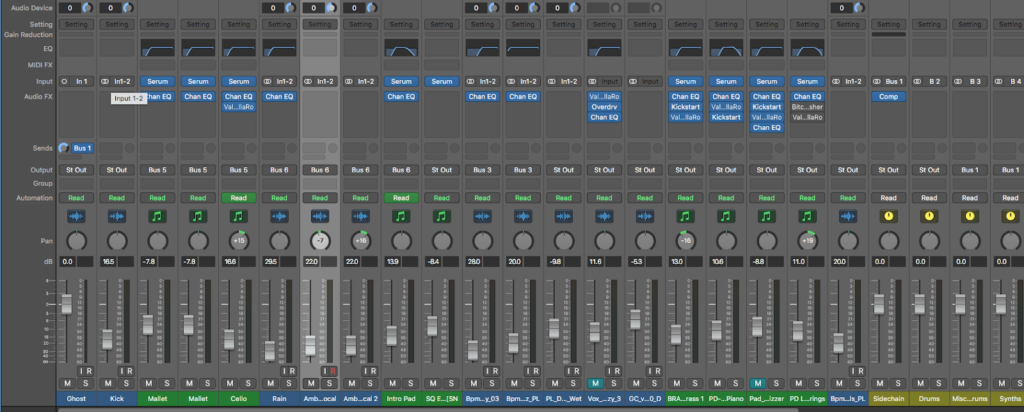
Mixing is an advanced skill that you generally pick up along the way. There are many courses and online tutorials to help you with the entire process.
Another added benefit of making music on your computer is digital effects. These include things such as reverb, delay, chorus, distortion, compression, and every other effect you can think of.
These effects will play an important role in making your track sound professional. It’s as easy as adding the effect to the track and playing around with a few settings.
Your DAW will come preloaded with most of the basic effects and mixing features. Of course, you will want to selectively upgrade certain features as your need grows. You’ll be happy to know that many producers still use a lot of the stock plugins when they are making their tracks.
Sound System
Beware, making music on your computer can be incredibly addicting. I will often start working on a track only to look up and see that four hours have disappeared. That being said, it’s one of the most creatively fulfilling skills I have learned.
No matter what your style of music, I’m sure you can start making it on a computer. As I mentioned above, get your hands on one of the free options available and get a taste of how satisfying it can be.
Thanks for reading – I hope this has inspired you to give making music on your computer a shot!
Making music on the computer is not reserved for the electronic musicians among us! Whether you play the electric keyboard or the tenor saxophone, you can take advantage of looping, EQing, effects, and all the other tools that DAWs have to offer.
The post The Beginner’s Guide To Creating Music On Your Computer appeared first on Musical U.
Learning to play what you hear in your head is a great be…
https://www.musical-u.com/learn/how-can-i-play-the-music-i-hear-in-my-head/
Learning to play what you hear in your head is a great benefit of musical ear training. Follow these three steps if you want to be able to play the music you imagine in your head on your instrument. https://www.musical-u.com/learn/how-can-i-play-the-music-i-hear-in-my-head/
